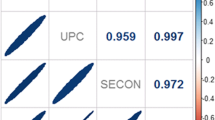Abstract
Continuity of contact between patients and physicians has become an important criterion of quality primary care. Using three measures of continuity that have appeared in the literature, this article examines, through the use of simulated data and through application to data from five primary care settings, the differences and utility of these approaches for measuring continuity. Further, these measures are applied to four selected diagnoses from each of the five sites, and the observed continuity scores afforded patients with these diagnoses are compared with those expected based on the population. Finally, the scores are correlated with the number of return visits prescribed and kept and with the rate at which laboratory studies are ordered. The findings indicate that site-specific differences in continuity prevail even after adjustments in the number of visits. Continuity based on selected diagnoses is greater, for the most part, than continuity afforded the patient population. Finally, continuity is related to the number of return visits prescribed but not to the number kept or the rate at which laboratory studies are ordered. The implications of continuity for other aspects of quality patient care are discussed.
Similar content being viewed by others
References
Breslau N, Haug M: Service delivery structure and continuity of care. A care study of pediatric practice in process of reorganization.J Health Soc Behavor 17339, 1976.
Bice TW, Boxerman SB: A quantitive measure of continuity of care.Med Care 15347–349, 1977.
Steinwachs DM: Measuring provider continuity in ambulatory care: an assessment of alternative approaches.Med Care 17551–565, 1979.
Mausner J, Bohn AK:Epidemiology: An Introductory Text. W.B. Saunders Company, 1974, pp. 136–138.
Nanboodiri NK, Carter LF, Blalock HM:Applied Multivariate Analysis and Experimental Designs. New York, McGraw-Hill, 1975, pp. 234–238.
Heagarty MC, Robertson LS, Kosa J, Alpert J: Save comparative costs—comprehensive versus fragmented pediatric care.Pediatrics 46596–603, 1970.
Becker MH, Drachman RH, Kirscht IP: New approach to explaining sick role behavior to low income populations.Am J Public Health 64205–216, 1974.
Rogers J, Curtis P: The concept and measurement of continuity in primary care.Am J Public Health 70122–127, 1980.
Additional information
Charles W. Given, Ph.D., is Associate Professor, Department of Family Practice, Michigan State University. Michael Branson, Ph.D., is Systems Planner, Medical Division, Conoco, Inc., Ponca City, Oklahoma. Rita Zemach, Ph.D., is Chief, Statistics Research Evaluation, Michigan Department of Public Health.
This work was supported by a Grant from the W.K. Kellogg Foundation.
Rights and permissions
About this article
Cite this article
Given, C.W., Branson, M. & Zemach, R. Evaluation and application of continuity measures in primary care settings. J Community Health 10, 22–41 (1985). https://doi.org/10.1007/BF01321357
Issue Date:
DOI: https://doi.org/10.1007/BF01321357




